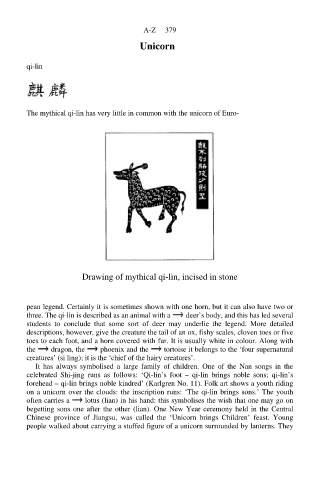Page 386 - A Dictionary of Chinese Symbols BIG Book
P. 386
A-Z 379
Unicorn Unicorn
qi-lin
The mythical qi-lin has very little in common with the unicorn of Euro-
Drawing of mythical qi-lin, incised in stone
pean legend. Certainly it is sometimes shown with one horn, but it can also have two or
three. The qi-lin is described as an animal with a deer’s body, and this has led several
students to conclude that some sort of deer may underlie the legend. More detailed
descriptions, however, give the creature the tail of an ox, fishy scales, cloven toes or five
toes to each foot, and a horn covered with fur. It is usually white in colour. Along with
the dragon, the phoenix and the tortoise it belongs to the ‘four supernatural
creatures’ (si ling); it is the ‘chief of the hairy creatures’.
It has always symbolised a large family of children. One of the Nan songs in the
celebrated Shi-jing runs as follows: ‘Qi-lin’s foot – qi-lin brings noble sons; qi-lin’s
forehead – qi-lin brings noble kindred’ (Karlgren No. 11). Folk art shows a youth riding
on a unicorn over the clouds: the inscription runs: ‘The qi-lin brings sons.’ The youth
often carries a lotus (lian) in his hand: this symbolises the wish that one may go on
begetting sons one after the other (lian). One New Year ceremony held in the Central
Chinese province of Jiangsu, was called the ‘Unicorn brings Children’ feast. Young
people walked about carrying a stuffed figure of a unicorn surrounded by lanterns. They

